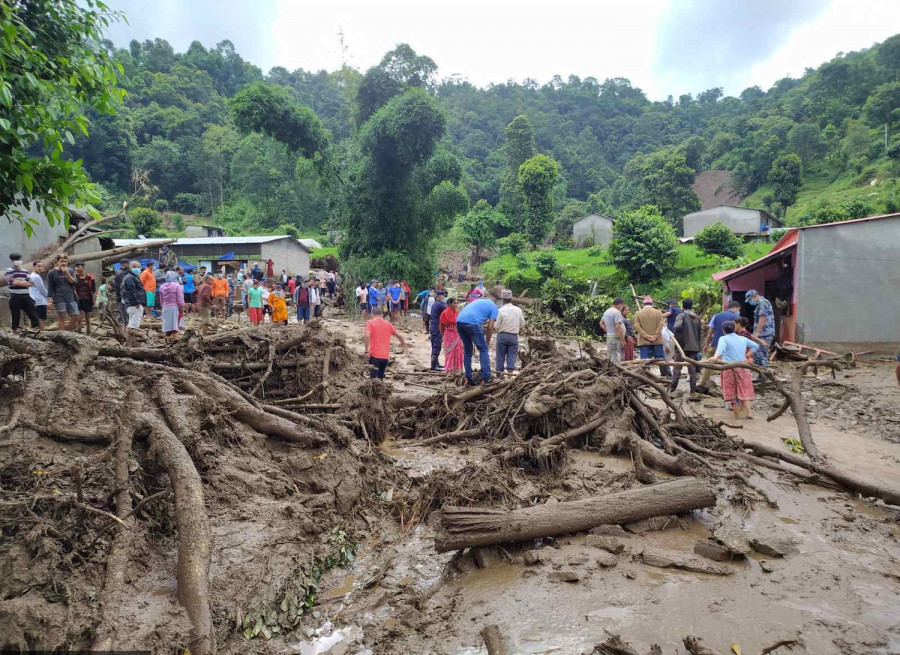Climate & Environment
‘Loss and damage’ crucial to Nepal’s COP27 agenda
As frequent and intense floods, heatwaves and droughts hit South Asia, adapting to these climate extremes is proving tough.
Aakriti Ghimire
One-third of Pakistan is under water. Almost half of the country’s crops have been washed away.
Over 33 million Pakistanis have been displaced as the country has received nearly 190 percent more rain this year between June and August than its 30-year average. The economic loss has been estimated at $10 billion so far.
The floods that followed the phenomenal heatwaves in April and May show how climate-vulnerable countries have now gone beyond adaptation.
The ‘loss and damage’ taking place in Pakistan aren’t isolated events in South Asia.
In early May 2022, heavy pre-monsoon rains in India’s northeastern states and Bangladesh left three million people stranded.
Nepal witnessed a dry spell in the middle of the monsoon season, leading to climate displacement.
All of these extreme events triggered by a warming climate occurred within a span of four months this monsoon.
As the frequency of such incidents increases in climate-vulnerable countries, the ability to adapt to the unpredictable weather events and disasters is also getting limited. Experts describe these events as loss and damage, which are “beyond the capacity of adaptation.”
As preparations for the 27th conference of parties, COP27, begin in Sharm-El Sheikh, Egypt, least developed countries like Nepal are prioritising loss and damage as one of their agendas. Experts, however, aren’t hopeful that the major global emitters of greenhouse gases will take responsibility for, or even acknowledge, the agenda.
“These extremities [climate change-induced disasters] lead to a situation of loss and damage, which is now beyond adaptation,” says Prabin Man Singh, programme director at the Prakriti Resources Center, a non-governmental organisation working for sustainable development and environmental justice. “However, there’s little hope that the COP27 will ensure the financing for loss and damage.”
Loss and damage include economic and non-economic losses incurred due to climate change that are increasingly becoming unavoidable. As frequent and intense floods, heatwaves and droughts hit South Asia, adapting to these climate extremes is proving tough.
Economic losses—that include loss of resources, goods and services, in the form of business operations, agriculture production, tourism, infrastructure and property—are projected to cost South Asia $518 billion by 2050.
Alongside that, non-economic losses related to human life, health, human mobility, territory, cultural heritage, indigenous knowledge, societal and cultural identities, and biodiversity and ecosystem services are taking place at an irreparable rate.
In Nepal, non-economic losses are more severe and direr than economic losses, experts say, and recovering from them all the more difficult.
“Nepal has seen more non-economic losses, which are even more difficult to recover from,” said Buddhi Sagar Poudel, joint secretary and head of Climate Change Management Division at the Ministry of Forests and Agriculture. “Climate change-induced disasters have led to a lot of displacement, migration, deaths, and loss of heritage and culture.”
Conversations on loss and damage can be dated back to 1991, but it was only in 2019, at the 25th conference of parties (COP25), that Santiago Network on Loss and Damage, a UN body that aims to assist developing countries vulnerable to climate change, was established.
However, this network cannot address the reality of loss and damage on the ground.
At the COP26, held in Glasgow last year, Least Developed Countries, including Nepal, pushed for establishing the Glasgow Climate Facility on Loss and Damage. That too failed to establish concrete mechanisms to deliver financial support to climate vulnerable countries.
At the upcoming COP27, one of the main agendas for Nepal’s position paper is again loss and damage. The ministry has formed the thematic group that is now undertaking research and assessing extreme climate events.
The thematic group will focus on developing three concrete agendas for Nepal’s position paper, officials say.
“First, we need loss and damage to be recognised as a stand-alone agenda, the way adaptation and mitigation are,” Poudel said. “Second, the Santiago Network should be made more operational and functional. And finally, we need an entirely separate funding mechanism for loss and damage.”
Climate experts say that the climate crisis has already moved beyond a situation where adaptation is possible. Dealing with such large-scale losses and damage isn’t possible with the sole focus on adaptation and mitigation, they say.
Meanwhile, worries remain that loss and damage may not get priority at the upcoming conference either. Given the global priority on mitigation and limiting rising temperatures below 1.5 degrees Celsius, experts are concerned that agendas might be divided.
“The developing world wants to prioritise loss and damage at the upcoming conference while the entire world is focused on keeping global temperatures from rising above 1.5 degrees Celsius,” says Madhukar Upadhya, a climate change and finance expert. “So the agenda of loss and damage might not get the attention it deserves at the upcoming global climate conference.”




 7.12°C Kathmandu
7.12°C Kathmandu











